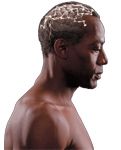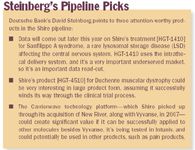Raising the Stakes in CNS
As brands are required to produce more and more data to convince not only regulators, but payers, physicians, and patients, Jeffrey Jonas is pushing Shire's "search and develop" R&D model into new and sometimes uncomfortable territory.
Conversations around value, and how to create it in 2012, can usually be separated into two categories: hard and soft. Hard value deals with operational efficiencies, getting a drug approved on time and executing on a quarterly sales goal. Soft value, on the other hand, has to do with addressing an unmet need, investing in services around a product, and improving health outcomes. Shire's Jeffrey Jonas, installed in 2008 as senior vice president, R&D, for the specialty business, believes that he can help the company do both, by placing the focus on clinical value, not p value, the latter being a statistical measure used to prove significant change or efficacy with a drug, compared against a chance result.

Getty Images: John Lund
Jonas joined Shire a month after Angus Russell took over as CEO, and quickly went to work on the company's prized ADHD portfolio, which included the newly approved prodrug Vyvanse (lisdexamfetamine dimesylate). With academic and entrepreneurial bona fides beyond dispute—Jonas received his MD from Harvard Medical School and was chief resident in psychopharmacology at Harvard's McLean Hospital, and has also founded and co-founded two biotech companies, in addition to serving as chief medical officer and EVP at Forest Labs, and EVP at Isis Pharmaceuticals—Jonas found himself in a position to change the way Shire approached product development. Based on Vyvanse's mechanism of action, a dopamine modulator, and the safety data produced in ADHD trials, Jonas wanted to test the drug for new indications. "When I got to Shire, there wasn't really much of a lifecycle management program in place for Vyvanse," recalls Jonas. "I was in a meeting very early on, and we had just started talking about a Vyvanse lifecycle management plan, and one of the comments from someone relatively senior was, 'This is very risky to do this. It's our major asset.' And my response was, 'Do you know what's risky? Having an asset with a patent life to 2024 without a lifecycle program. That's risky.'"

R&D organizations who are struggling to justify their existence go for a p value. Clinical organizations that are struggling to get a molecule on the market that helps patients are testing for a clinically relevant value. -Jeffrey Jonas
In collaboration with the commercial group, Jonas's more aggressive approach toward product development has already resulted in an additional indication from FDA for Vyvanse—as a maintenance treatment for adults with ADHD—and the drug is currently being tested in four new areas: major depressive disorder, negative symptoms and cognitive impairment in schizophrenia, excessive daytime sleepiness, and binge eating disorder. These new clinical programs push the limits of Shire's "search and develop" model, causing the company to make difficult choices about when it makes sense to go into the clinic, and when it makes sense to duck out. If the hard and soft value categories are a Venn diagram, then clinical trials can only go forward in the intersection. For now, Shire isn't interested in doing five-year, Kaplan-Meier-style outcome studies, says Jonas, because those kinds of programs too greatly elongate the development cycle. But Jonas isn't afraid to take his lead asset into a head-to-head trial versus a competitor. In March, Shire announced two Phase IV clinical trials comparing Vyvanse to Concerta. Speaking on the decision to go head-to-head, Jonas says the purpose is to "show that my drug is better, or I'm wrong." The way to de-risk a head-to-head trial or other potentially dangerous clinical adventure, says Jonas, is to take a broader look at the clinical implications beyond sheer efficacy. "R&D organizations who are struggling to justify their existence go for a p value. Clinical organizations that are struggling to get a molecule on the market that helps patients are testing for a clinically relevant value," he says.
Quality of life as value
One way to answer the value question in CNS areas like depression, Alzheimer's disease, or ADHD comes from social science as much as it comes from the laboratory. "We're in an age where patient reports, rating scales, and subjective measures are now almost requirements," says Jonas. "A lot of [industry executives] have come out of CNS specifically because of their ability to deal with murky, fuzzy data...it's the most difficult thing we do in our industry." Technology has made surveys and questionnaires much easier to conduct and process, but fundamentally you're still asking the patient for a self-reported assessment. Jonas says the "methodologies around validation have been firmed up" with FDA. Regulators may not be ready to accept every quality of life measure as a consideration for approval, but these measures can open doors with payers, physicians, and patients.
Jonas says productivity measures like missed days at work or at school can be used as data points to establish value. But to what extent can a caretaker scale influence an approval decision? "We're looking at some novel approaches in Europe that unfortunately I can't talk about, but that may give us some answers," says Jonas. Vyvanse is currently approved in the United States, Brazil, and Canada, and in January, the drug was accepted for review by the Medicines Healthcare products Regulatory Agency (MHRA) in the United Kingdom. Vyvanse would go by Venvanse in Europe, as it does in Brazil.

Asked for an opinion on Jonas's preference for clinical value instead of p value, David Steinberg, managing director, equity research, specialty pharmaceuticals at Deutsche Bank, said, "Well, to get approved you need a p value that is statistically significant." True, but regulatory approval is just one of the several approvals needed for a successful brand; if payers don't approve, for example, a regulatory approval isn't worth much. "I think the greater the value proposition you can bring to the payers, the better," added Steinberg. On the merits of a head-to-head versus Concerta, Vyvanse for adults, and the clinical evaluation of Vyvanse as a possible treatment for binge eating, Steinberg says the strategy makes sense. "It looks to be a clever strategy in that they're trying to extract a lot more value out of an already approved molecule."
Differentiation as development
At ISIS and at Forest Labs, Jonas worked on products where differentiation was critical to market success, and that experience has carried over into his work at Shire. "If you look at what ISIS did with mipomersen [a treatment for a rare genetic lipid disorder] we differentiated into an area where there was a clear unmet medical need. That was based not only on mechanism of action, but also on the issue of how it would be tolerated...the whole thesis was, go into an area where nothing else worked." This strategy is similar to Jonas's decision to bring Vyvanse into the clinic for negative symptom predominant schizophrenia; the investigational Phase II study delivered positive results in April, and was given Fast Track designation by FDA. "Most patients with schizophrenia have residual symptoms, significant morbidity, unmet medical need...nothing really works that well," says Jonas. "[Vyvanse] was so well tolerated at 70 milligrams, which completely defied conventional wisdom." In a statement on the results, Dr. Henry Nasrallah, professor of psychiatry and neuroscience and director of the schizophrenia research program at the University of Cincinnati College of Medicine, said, "If these results are confirmed in controlled clinical trials, they would represent a significant step forward to address the unmet need of treating the negative symptoms of schizophrenia, including a fundamental reexamination of dopaminergic and noradrenergic transmission across brain regions in treating the negative symptoms" of the disorder.

I think the greater the value proposition you can bring to the payers, the better. -David Steinberg
At Forest, Jonas says Lexapro was "one of my programs," and "we did head-to-heads with everyone." To differentiate a product successfully, development programs must go beyond "some loosey-goosey, let's compare two labels" kind of approach. "Every Shire product will have a concrete value proposition. It may be quality of life, it may be return to work...we'll find some pharmacoeconomic measure that's relatable to payers and physicians and patients," says Jonas. "I'm fortunate that our CEO will actually let us put our money where our mouth is on this."

Jonas has a thesis—unproven—that "if you treat kids earlier [for CNS disorders], the ingrained behaviors that may be debilitating later on don't ever develop." The question then becomes, "If you can prove it, can you claim it? It is possible, for example, to show that productivity is enhanced by treatment." This idea raises many questions, not least of which would be the establishment of an acceptable definition of "productivity" in this context, but there's another problem. "The one fly in the ointment for all of this is that a lot of times you don't understand the full value of the drug until it's on the market for a awhile. So to some extent, while all of us want to add value, it does require a certain amount of prescience on the part of the developers to know where that value might be. And we probably lose out on some opportunities for this reason," says Jonas.
Laddering up to commercialization
As a mid-sized specialty firm with a rare diseases business and a recently added regenerative medicine unit—the latter of which Jonas also serves as SVP, R&D—Shire can't succeed through brute force, says Jonas. "We're not going to give sales reps data and just hope they can make a market. They have to have real data, comparator data, that's how a specialty model thrives." Generating so-called "real" data can be a problem in CNS, particularly at the earliest stages, which is one of the reasons that Jonas is happy to stay out of the discovery game with Shire. "People use these animal models that really aren't relevant to beings with frontal lobes and cortexes...the models are anthropomorphized," says Jonas. "I don't know when a rat is really sad. Is not running on a wheel sad? I don't know." Jonas believes that CNS is a pragmatist's game, and it's an incrementalist market for treatment of depression. The way forward in depression will be to focus on treatments for patients that don't respond to currently available products; Vyvanse is being studied as an adjunctive therapy. "You'll see new antidepressants get launched. Will they be fully differentiated? No. Will they do fine? Yeah. But we're not interested in the brute force model," says Jonas, adding that data requirements for making promotional claims will force the sales model to evolve. In the first quarter of 2012, Intuniv (guanfacine), Shire's third best-selling ADHD drug (behind Vyvanse and Adderall XR, respectively) increased its sales by 54 percent compared with first quarter of 2012, a development Angus Russell, on an earnings call, attributed to "new consumer marketing campaigns" and an expanded approval last year for use as an adjunctive therapy in combination with a stimulant.
In addition to Shire's patient marketing efforts in ADHD (which currently involve a retired Philadelphia Phillies outfielder, and a pop/rock singer), there's "a group of non-promotional sales reps who are not compensated by sales but are actually more geared toward disease state," says Jonas. Shire is also "growing our medical science liaison (MSL) organization in Europe, to prepare to work with European thought leaders around launching" Vyvanse. The company has an in-house program in the works called "virtual MSL" that "will allow MSLs to be available for questions any time, 24/7," says Jonas. Offering up the obligatory comment with respect to selling medicines in Europe, Jonas says companies "have to pay attention to reimbursement strategies because it's almost like you have two parallel paths you must follow to get the drug on the market, the regulatory and the pricing."
Steinberg says that Europe "seems finally ready for the ADHD market to take hold, and who's better in ADHD than Shire?" Global expansion is an important strategic initiative at Shire, and last November the company announced a partnership with Shionogi to "co-develop and co-commercialize certain of Shire's ADHD medicines in Japan," but the specifics of the deal were not disclosed. Shire's last co-promote deal on Vyvanse ended badly. The three-year agreement struck in 2009 with GlaxoSmithKline was an attempt to expand Vyvanse's reach to US primary care docs, but it fizzled in September of 2010, after sales goals were not achieved, and no payment was made (or was due, per the agreement), to GSK.
Interestingly, Shire's decision to go for a binge eating indication would most likely require additional sales reps, per Steinberg and probably the muscle of a large pharmaceutical company. Shire says binge eating patients are the province of psychiatrists, and they have that covered if the indication is approved. There are no currently approved treatments for binge eating, and primary care docs would presumably be making most of the diagnoses. Jonas is very bullish on a binge eating indication, but says he'll live or die by the data results. "I think it's a major opportunity. The patients are well-defined, and the pharmacoeconomics will be good, so I'm very excited about it, if the study is positive....I think it's an opportunity that might dwarf almost everything else we're doing, in terms of value and in terms of time to market." For a diagnosis of binge eating disorder to be made, a patient must experience binges for two days per week for a minimum of six months.
Jonas says Shire has built up its health economics group and its assessments group in recent years, and new talent has been brought in, and talent has departed. On the latter point, Michael Cola, president of specialty pharmaceuticals, announced his resignation at the end of March. But the biggest cultural shift since Jonas came on board has been "the acknowledgement of how you take risk and how you stop projects as well as keep them going when they're successful."
Float or bloat in R&D
Jonas acknowledges the Shire "search and develop" model, but says it's more like "search and rescue," since "there are lots of really good assets out there that may have languished because of regulatory uncertainty." Innovation at the discovery level, says Jonas, has to come from multiple sources, which is why Shire's model makes sense. "Who in their right mind would hook themselves up to one supplier or one thesis?" he wonders. "If you acknowledge that innovation has to come from everywhere, not just internal, the whole thesis of being an R&D organization goes away. Why would I want that?" Once a drug goes from preclinical and animal studies to human subjects, at that point "skill sets are more transferable and more stereotyped; and there you want to bring some things in-house," says Jonas. On conducting trials, he says smaller is better. "I don't need a thousand patients because if I'm looking for a bigger effect, I need a smaller study. The point is that if you need more than 75 patients per arm, you're looking for significance, not value. That's how we see it."
Other big pharmaceutical companies would almost certainly dispute this conclusion, but Jonas says that organizations that focus on discovery are "intrinsically building infrastructure and intellectual bureaucracies...they develop an inertia that impedes innovation because very few people will say, 'That molecule and mechanism is better than mine. Fire me and bring that in.'" Despite a desire to keep clinical trials small, programs exceeding 1,000 patients are almost inevitable, and Shire's Phase III program in depression for Vyvance is roughly 1,500 patients, Jonas said on the earnings call. He expects a Phase III binge eating trial to be of similar size, but said the programs are "easily manageable by Shire, and are well within our wheelhouse for how we operate."
Intersection of value
As a kid, Jonas used to hang around the Graybar building, on Lexington Avenue in New York City's midtown. "My father was a dress buyer, and the Graybar building was a cutting factory," he says. The experience was influential. "At some point, we've got to look at ourselves like a retail business. We need products, an immediate product that's better and more effective, or has some kind of value to offer."
Will Jonas's approach to R&D at Shire—based on demonstrating large effect sizes in small clinical programs, and leveraging quality of life measures—take the CNS franchise into new realms and revenue streams? Can Shire stake out the middle ground between hard and soft value in CNS, and keep shareholders and the street happy at the same time? Based on full-year earnings in 2011, Shire's specialty division, which includes the ADHD portfolio plus six other key products (three of which are for GI conditions), comprises 61 percent of the business, and brought in $2.6 billion in sales, an increase of 18 percent from 2010, according to company reports. The jury is still out on the company's regenerative medicine unit, which also falls under Jonas's remit, but Shire has a history of "out of the box" acquisitions, says Steinberg, pointing to the success of the human genetic therapies business unit. For Vyvanse, Shire has predicted blockbuster sales this year. With another decade of patent protection in the United States and Europe, a growing middle class in Asia and Latin America and an entrance into Japan via Shionogi, Shire seems poised to expand the brand into new therapeutic areas and geographies. But as Jonas says, the CNS category is a murky one when it comes to the production and management of data. For the strategy to work, regulators, payers, physicians, and patients will also need to broaden their perspective, and decide what value means to them.

Addressing Disparities in Psoriasis Trials: Takeda's Strategies for Inclusivity in Clinical Research
April 14th 2025LaShell Robinson, Head of Global Feasibility and Trial Equity at Takeda, speaks about the company's strategies to engage patients in underrepresented populations in its phase III psoriasis trials.
Pfizer Discontinues Development of Danuglipron for Chronic Weight Management
April 15th 2025Despite meeting key pharmacokinetic goals, a potential case of drug-induced liver injury led Pfizer to conclude that danuglipron’s risk-benefit profile did not support further development for chronic weight management.
The Misinformation Maze: Navigating Public Health in the Digital Age
March 11th 2025Jennifer Butler, chief commercial officer of Pleio, discusses misinformation's threat to public health, where patients are turning for trustworthy health information, the industry's pivot to peer-to-patient strategies to educate patients, and more.